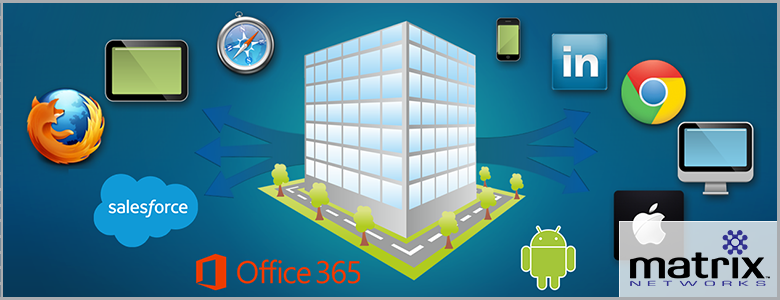
When it comes to managing your business over the Internet, it’s important to have connectivity and solutions in place that allow you to monitor your network and ensure performance and reliability to remote applications. To that end, SD-WAN (Software Defined Wide Area Network) is fast becoming the go-to option for companies both large and small who want to integrate more cloud services for employees to use.
If you’re new to SD-WAN or don’t know what it can do, there are some clear benefits of this technology, especially when compared to antiquated network methods like MPLS. The older methodology is not designed to work with a company migrating services to the cloud. As the migration occurs, the traditional site-to-site connections become less important and general internet gains value. The problem becomes you are managing two separate networks, a private internal network and a public facing internet environment, each with critical applications but separate paths, redundancy, speeds, and more. Using SD-WAN gives you one network to manage, with intelligent routing based on where the tools or data lives, public cloud or private network.
Single Site Business
Even if you have just one location, that doesn’t mean you can’t benefit from an optimized wide area network. Since SD-WAN arrived, businesses with a single site can gain major value out of an SD-WAN solution. By installing multiple internet connections and a SD-WAN deployment you can deliver on QoS, active/active internet behavior, same IP failover, increased speed to the internet, and provide visibility with reporting of the data and apps you use. The technology analyzes your traffic and routes it over many different connection paths, automatically adjusting the network path and packet flow to prioritize important and real-time traffic.For example, you can improve access and network performance to cloud offerings like the ones listed below: (for our cheat sheet on acronyms click here)
Multi-Site Business
For organizations with multiple branches, SD-WAN is a life saver. Not only do the individual branch locations gain the value offered to a single site business (fail-over, increased speed, etc.) the solution can provide mesh-style VPN connections between locations, displacing your expensive legacy network and simplifying failover without complex BGB routing. SD-WAN can also be used in conjunction with existing legacy network to provide a hybrid environment. This type of configuration allows traffic to flow over the controlled traditional environment or the free flowing internet side, based on your specific preferences. Whether your SD-WAN solution is a hybrid or replacement of an existing environment, the value for a business with multiple branches is tremendous.
Office 365
Not that long ago IT teams would install the latest version of Office onto your computer and there it would remain until you removed it or upgraded it to a new, more complex version. Microsoft is leading the way in the subscription-only realm, meaning that for a monthly or annual fee you can access the program, but it’s not yours to keep. It's the cloud model, with Office 365 setting the cloud standard in many ways. While we could spend all day arguing about the ethics and functionality of the cloud engine, the fact is that you need a stable connection to get all of your Microsoft Office programs. To help you get the most of Office, SD-WAN can ensure your O365 traffic is routed in the most direct path to reach the Azure cloud. With more of these applications becoming bandwidth intensive (OneDrive and SharePoint) or real-time (Skype for Business) it is critical that SD-WAN manage and prioritize that traffic.
Hosted Voice
In the future, our smartphones will cease to be phones and instead only be mobile Internet tablets. As Internet bandwidth becomes stronger and more reliable, so will our ability to talk online. Services like Hosted Voice provide your business with all of the benefits of a traditional phone system without any of the downsides. Even with a single circuit, SD-WAN can improve your connection to your customers from wherever they are, allowing you to route all calls through a commodity grade network with QoS instead of maintaining an expensive separate phone network. It doesn’t take a Gartner report to know smartphones are fast becoming the preferred communications tool for business and personal use. The evolution of traditional phone systems to cloud based systems is a similar evolution. We no longer want to purchase expensive hardware to run our communications platform, instead opting for subscription based services that allow the flexibility to move onto future platforms and tools. With this migration to voice in the cloud, SD-WAN becomes critical in shaping, prioritizing, and choosing the best route for voice to travel.
Cloud CRM
When it comes to interacting with your customers, you need a fast and efficient way to reach out to them and engage. CRM (Customer Relationship Management) software has become the name of the game. Having CRM in the cloud means you always have the newest, most powerful version of the solution. Redundancy is baked in and APIs (Application Programming Interface) are included allowing you to integrate your different tools in one place. Although the backend infrastructure of these platforms is incredible, in the end it is riding your local internet circuit. SD-WAN ensures your connection to these tools is not only fast, but ultra-reliable and with low latency.
Built-in Reporting and Administration
SD-WAN not only manages all of your traffic and directs it along the best path, it also measures everything it does. This gives you a visual into the performance of your Internet connections, what traffic and applications are in high use, and at the same time allows you to make adjustments to routing or prioritization globally in a few keystrokes. For example, SD-WAN can make your world better during a dispute with a carrier by giving you precise reporting on their performance. It can also give you the tools to see that one of your sites has a large amount of bandwidth-sucking Netflix traffic and the tools to cap it.
Reduce costs in Network
Finally, the biggest reason to convert to SD-WAN is that you can save a boatload of money. If your company is using an antiquated system like MPLS, it can cost you hundreds of thousands, if not millions of dollars a year. With SD-WAN, you can reduce your spending by as much as seventy percent. Increased Internet speed can have a huge impact on productivity and cost savings. If downloads of big files are ten seconds faster and you download 3 large files a day, it would save each staff member a little more than two hours a year in waiting time. Additionally, SD-WAN outages are rare, meaning that you also won’t have to worry about losing productivity as a result of the network going down. Overall, SD-WAN can provide you with everything your business needs at a fraction of the cost of installing a physical network.
Next Article: Managing Multiple Locations? SD-WAN & VPN FTW!
Author: Kyle Holmes



.svg%20(1).png?width=55&name=1200px-Logo_of_YouTube_(2015-2017).svg%20(1).png)

